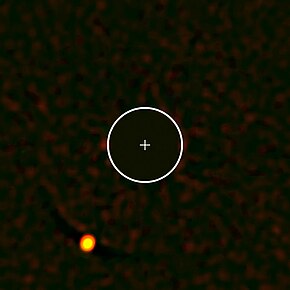Loading AI tools
Hot Jupiter exoplanet orbiting HIP 65426 From Wikipedia, the free encyclopedia
HIP 65426 b, formally named Najsakopajk,[3] is a super-Jupiter exoplanet orbiting the star HIP 65426. It was discovered on 6 July 2017 by the SPHERE consortium using the Spectro-Polarimetric High-Contrast Exoplanet Research (SPHERE) instrument belonging to the European Southern Observatory (ESO).[6][7] It is 385 light-years from Earth.[8] It is the first planet discovered by ESO's SPHERE instrument.[9]
 HIP 65426 b is on the lower left of the image, with the circle representing what Neptune's orbit would look like around the star HIP 65426, represented by a small cross. | |
| Discovery[1] | |
|---|---|
| Discovered by | SPHERE consortium[2] |
| Discovery date | 6 July 2017 |
| Direct imaging | |
| Designations | |
| Najsakopajk[3] | |
| Orbital characteristics | |
| 87+108 −31 au[4] | |
| Inclination | 100+15 −6 deg[4] |
| Physical characteristics | |
| Atmospheric model: 0.92±0.04 RJ[4] Evolutionary model: 1.45±0.03 RJ[4] | |
| Mass | 7.1±1.1 MJ[4] |
| 4.07±0.19 dex | |
| Temperature | Atmospheric model: 1667+25 −24 K[4] Evolutionary model: 1282+26 −31 K[4] |
In August 2022, this planet and its host star were included among 20 systems to be named by the third NameExoWorlds project.[10] The approved names, proposed by a team from Mexico, were announced in June 2023. HIP 65426 b is named Najsakopajk and its host star is named Matza, after Zoque words for "Mother Earth" and "star".[3]
The exoplanet HIP 65426 b orbits its host star HIP 65426, an A2V star with apparent magnitude 7.01 and a mass of 1.96±0.04 M☉.[11] This planetary system is located in the constellation Centaurus. The planet is around 14 million years old. However, it is not associated with a debris disk, despite its young age,[7][8] causing it to not fit current models for planetary formation.[12] It is around 92 AU from its parent star, with a possible dusty atmosphere.[13] It was discovered as part of the SHINE program, which aimed to find planetary systems around 600 new stars.[1]
In September 2022, HIP 65426 b became the first exoplanet directly observed by the James Webb Space Telescope.[14]
The spectrum taken in 2020 has indicated that HIP 65426 b is carbon-poor and oxygen-rich compared to Solar System gas giants.[5]
Spectral analysis of data from the James Webb Space Telescope revealed strong evidence of silicate clouds containing enstatite with no evidence of a dusty atmosphere.[15]
In August 2022, a pre-print of the James Webb Space Telescope (JWST) observations was published. The JWST direct imaging observations between 2-16 μm of HIP 65426 b tightly constrained its bolometric luminosity to , which provides a robust mass constraint of 7.1±1.1 MJ. The atmospheric fitting of both temperature and radius are in disagreement with evolutionary models. The team also constrained the semi-major axis and the inclination of the planet, but the new JWST astrometry of the planet did not significantly improve the orbit of the planet, especially the eccentricity remains unconstrained.[4]
HIP 65426 b is the first exoplanet to be imaged by JWST and the first exoplanet to be detected beyond 5 μm. The observations[16] demonstrate that the James Webb Space Telescope will exceed its nominal predicted performance by a factor of 10 and that it will be able to image 0.3 MJ planets at 100 au for main-sequence stars, Neptune and Uranus-mass objects at 100-200 au for M-dwarfs and Saturn-mass objects at 10 au for M-dwarfs. For α Cen A JWST might be able to push the limit to a 5 R🜨 planet at 0.5 to 2.5 au.[4]
Seamless Wikipedia browsing. On steroids.
Every time you click a link to Wikipedia, Wiktionary or Wikiquote in your browser's search results, it will show the modern Wikiwand interface.
Wikiwand extension is a five stars, simple, with minimum permission required to keep your browsing private, safe and transparent.